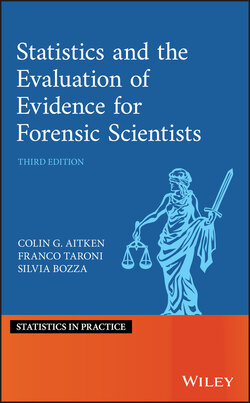Читать книгу Statistics and the Evaluation of Evidence for Forensic Scientists - Franco Taroni - Страница 2
Table of Contents
Оглавление1 Cover
2 Wiley Series in Statistics in Practice
3 Statistics and the Evaluation of Evidence for Forensic Scientists
4 Copyright
5 Dedication
6 Foreword
7 Preface to Third Edition
8 Preface to Second Edition Note
9 1 Uncertainty in Forensic Science 1.1 Introduction 1.2 Statistics and the Law 1.3 Uncertainty in Scientific Evidence 1.4 Terminology 1.5 Types of Data 1.6 Populations 1.7 Probability Notes
10 2 The Evaluation of Evidence 2.1 Odds 2.2 Bayes' Theorem 2.3 The Odds Form of Bayes' Theorem 2.4 The Value of Evidence 2.5 Errors in Interpretation 2.6 Misinterpretations 2.7 Explanation of Transposed Conditional, Defence Attorney's and False Positive Fallacies 2.8 Making Coherent Decisions 2.9 Graphical Probabilistic Models: Bayesian Networks Notes
11 3 Historical Review 3.1 Early History 3.2 The Dreyfus Case 3.3 Statistical Arguments by Early Twentieth‐Century Forensic Scientists 3.4 People v. Collins 3.5 Discriminating Power 3.6 Significance Probabilities 3.7 Coincidence Probabilities 3.8 Likelihood Ratio Notes
12 4 Bayesian Inference 4.1 Introduction 4.2 Inference for a Proportion 4.3 Sampling 4.4 Bayesian Networks for Sampling Inspection 4.5 Inference for a Normal Mean 4.6 Quantity Estimation 4.7 Decision Analysis Notes
13 5 Evidence and Propositions: Theory 5.1 The Choice of Propositions and Pre‐Assessment 5.2 Levels of Propositions and Roles of the Forensic Scientist 5.3 The Formal Development of a Likelihood Ratio for Different Propositions and Discrete Characteristics 5.4 Validation of Bayesian Network Structures: An Example 5.5 Pre‐Assessment 5.6 Combination of Items of Evidence Notes
14 6 Evidence and Propositions: Practice 6.1 Examples for Evaluation given Source Level Propositions 6.2 Examples for Evaluation given Activity Level Propositions 6.3 Examples for Evaluation given Offence Level Propositions 6.4 Summary Notes
15 7 Data Analysis 7.1 Introduction 7.2 Theory for Discrete Data 7.3 Theory for Continuous Univariate Data 7.4 Normal Between‐Source Variation 7.5 Non‐normal Between‐Source Variation 7.6 Multivariate Analysis 7.7 Discrimination 7.8 Score‐Based Models 7.9 Bayes' Factor and Likelihood Ratio (cont.) Notes
16 8 Assessment of the Performance of Methods for the Evaluation of Evidence 8.1 Introduction 8.2 Properties of Methods for Evaluation 8.3 General Topics Relating to Sample Size Estimation and to Assessment 8.4 Assessment of Performance of a Procedure for the Calculation of the Likelihood Ratio 8.5 Case Study: Kinship Analysis 8.6 Conclusion Notes
17 A AProbability DistributionsProbability Distributions A.1 Introduction A.2 Probability Distributions for Counts A.3 Measurements Notes
18 B BMatrix PropertiesMatrix Properties B.1 Matrix Terminology
19 References
20 1 Notation
21 Cases
22 Author Index
23 Subject Index
24 End User License Agreement
